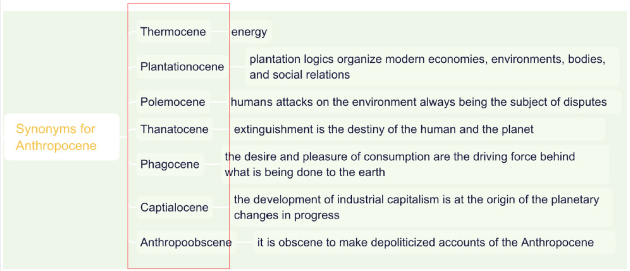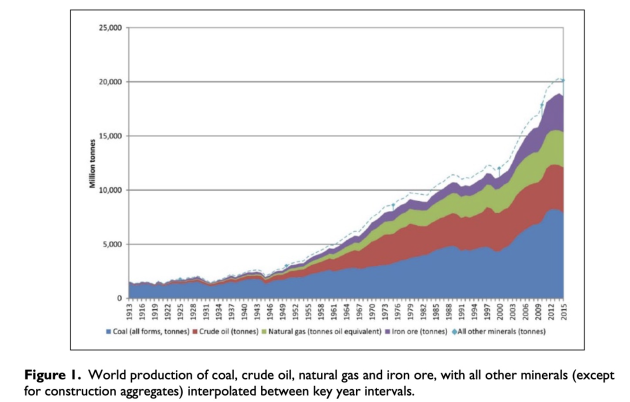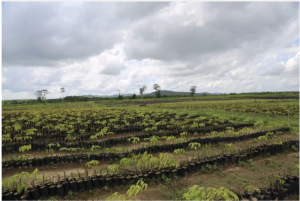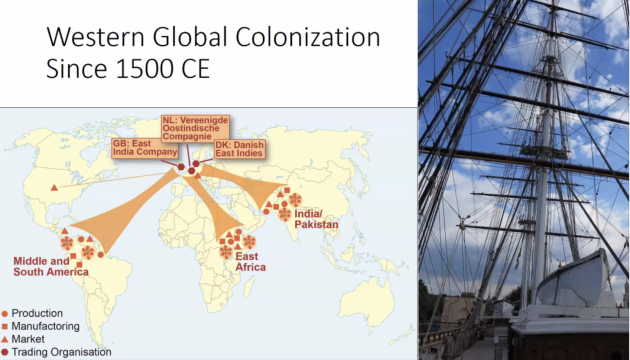Interpretations of the Anthropocene
Bonneuil and Fressoz, 2016 The Shock of the Anthropocene : The Earth, History and Us.
(Anthony H Cooper et. al 2018 )
By 2015, the most significant by mass of world production are coal 39%, oil 21%, and natural gas 16% ;
Over time, the production amounts of coal, crude oil, and nature gas has been increasing.
Where was the energy transition?
Thermocene
Bonneuil and Fressoz contest that the truth of the seeming energy transition in the history of energy is successive additions of new sources of primary. It is the confusion between relative (the use of coal decreased in relation to oil) and absolute (the consumption of coal remains continually grew), between local and global that creates this illusion.
Energy transitions “follow neither an internal logic of technical progress, nor a logic of scarcity and substitution, nor even a logic that was simply economic, and history of energy is above all one of political, military and ideological choices that involve with strategic interests and objectives of certain social groups”.
Plantationocene
Estimates suggest that 75 million acres of land worldwide have been sold or leased in the past decade to foreign investors for large-scale oil palm, rubber, and other agricultural concessions.
The plantation, as Sidney observed, was a “synthesis of field and factory,” an agro-industrial system of enterprise integral to the historic rise and growth of capitalism.
Rubber seedlings await planting on a concession granted to Firestone
Tire & Rubber Company by the Liberian government in 1926. Firestone’s
99 year lease for up to one million acres of land in Liberia paved the
way for the current wave of land concessions to foreign investors in
Liberia. Photo by Gregg Mitman.
Rüdiger Glaser, 2021
Polemocene
It re-evaluates criticisms of anthropocenic action since the dawn of industrialisation.
It is a history of socioecological struggles and challenges to the damages of industrialism, where people defend the forest, its rights of usage and the planet, people question machines and mass production, people are opposite to innovations. Bonneuil and Fressoz use this 'cene to emphasize a long history of political struggle motivated by social justice and "environmentalism of the poor". Despite of this resistance, they failed to prevent industrialism’s expansion from the Industrial Revolution through the Cold War to today.
Thanatocene
It is the natural history of destruction. a teleological view that, extinguishment is the destiny of the human and the planet that is now in the stage of intense destruction, which owes to the global mobilizations of the Second World War.
As the twentieth century progressed, wars became both deadlier and more frequent. Troops were supported, and to a certain degree replaced, by extraordinarily powerful machines, technological and logistic systems. War machines that required growing quantities of raw materials and energy had an unprecedentedly heavy impact on the environment.
The contemporary aircraft industry is likewise a product of the Second World War, both technologically (aluminium, radar, jet engines) and institutionally. The Second World War thus prepared the technological and legal framework for mass-consumption society.
Phagocene
This interpretation revolves around consumerism. Consumerism is a social and economic order that encourages people to acquire goods and services in ever-increasing quantities. With the advent of the Industrial Revolution, the supply of goods outstrips consumer demand, as a result of mass production led to overproduction, so manufacturers turned to planned advertising to manipulate consumer spending.
Captialocene
From the perspective of captialocene. The last three centuries have been characterized by an extraordinary accumulation of capital: despite destructive wars, this grew by a factor of 134 between 1700 and 2008. The dynamic of capital accumulation gave rise to a ‘second nature’ made up of roads, plantations, railways, mines, pipelines, wells, power stations, futures markets and container ships, financial positions and banks that structure flows of matter, energy, goods and capital on a world scale. It is this profit-oriented technostructure that swung the Earth system into the Anthropocene. The change in geological regime is the act of the ‘age of capital’, rather than simply the ‘age of man’ as the dominant narratives claim.
Anthropoobscene
One view from Anthropo-obscene is that it is impotant to make depoliticized accounts of the Anthropocene. This concept could be listed on top 10 most difficult terminology in Anthropocene. It is a reflection of the reflection on the Anthropocene. The debate on the Anthropoobscene tries to figure out whether the interpretation of Anthropocene is associated with politics. For example, scholar Erik Swyngedouw attempts to defense that the matter of ecology is fundamentally de-politicised. And he clams that the “political” cannot and should not be grounded on the eventual truth of the Anthropocene.
• Gemenne et al., 2019.12 Atlas de l’Anthropocène
• Sophie Sapp Moore 2019, 1 Plantation Legacies



